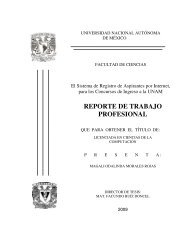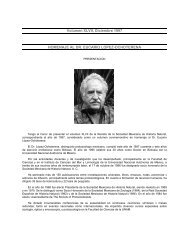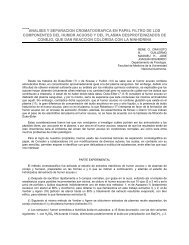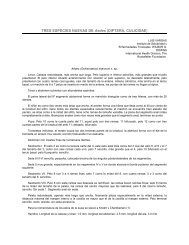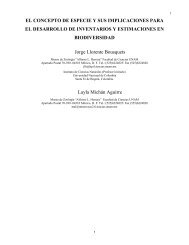Vernworn (1889), setting the stage for much research in such areas in the years following that date. An oftenneglected treatise, a kind of textbook on the cell and, especially, on the protozoa, was the volume produced near theend of the century by De<strong>la</strong>ge and Hérouard (1896). The work inclu<strong>de</strong>s a well-organized systematic treatment of thec<strong>la</strong>sses, or<strong>de</strong>rs, families, and genera of the protozoa, while not overlooking their physiology and their reproductiveprocesses. The French authors <strong>de</strong>monstrate a refreshingly original approach to numerous problems concerning theorganization, function, and systematics of the diverse protistan groups covered in their monograph.EARLY 20TH CENTURY DISCOVERIES OR EVENTS IN PROTOZOOLOGYA goodly number of the workers cited in preceding sections --or at least their first generation stu<strong>de</strong>nts--continued to carry out significant work, including the making of new discoveries of importance, on into the presentcentury. These <strong>de</strong>serve our consi<strong>de</strong>ration here, even though it would be impossible to review in this particu<strong>la</strong>r paperthe entire 91 years of 20th century protozoology that have now passed. Perhaps the single most salient fact aboutthe turn of the 19th century was the advent of protozoological/ protistological research, on a <strong>la</strong>rge scale, in theUnited States of America. This ultimately led to the production of English-<strong>la</strong>nguage textbooks, the appearance ofgreat centers of research, and the formation of new professionals societies: The Society of Protozoologists (in theyear 1947), with its own journal (commencing in the year 1954), and the Phycological Society of America (year 1946)with its journal (1965). The training of many young people commenced, persons stimu<strong>la</strong>ted to recognize the protistseither as material of interest for their own sake or as i<strong>de</strong>al mo<strong>de</strong>ls for attacking problems, pure and applied, in cellbiology, ecology, conservation, evolution, genetics, taxonomy, and even biomedicine.We should not fail to point out that the 20th century marked the time of the rise of interest in the protozoa inmany other non-European countries or part of the world as well: the Orient, India, Israel, New Zea<strong>la</strong>nd, Mexico,South America, etc. But elsewere the growth was not on the scale witnessed in the U.S.A., with its greater popu<strong>la</strong>tionof scientists interested in research in areas of cell biology and microscopy and microbiology generally. The oftenclose association of Americans with various European <strong>la</strong>boratories long <strong>de</strong>voted to carrying out protozoologicalinvestigations was another factor favoring the rapid increase in work on this si<strong>de</strong> of the At<strong>la</strong>ntic Ocean.RESEARCH IN GERMANY AND THE REST OF EUROPEGermany protozoologists still dominated the field at the turn of the century, both conceptually and in productionof taxonomic and other monographs in areas including both free-living and symbiotic groups. As implied above,many such investigators (some from countries other than Germany) were trained by the earlier lea<strong>de</strong>rs alreadymentioned on proceeding pages, particu<strong>la</strong>rly Bütschli, Haeckel, and Hertwig. Space permits only briefest mention ofselected persons. In parasitological areas, Doflein worked on a variety of protists; but he will be remembered longestfor his production of a most authoritative edition on protozoan parasites, first of its kind (Doflein, 1901; with the 6thand <strong>la</strong>st edition published as Doflein and Reichenow, 1949-1953, long after his <strong>de</strong>ath). Reichenow, 10 yearsDoflein's junior, produced brilliant studies on the life cycles and phylogeny of the coccidian haemogregarines andhaemosporidians (e.g., see Reichenow, 1910, 1921, 1940), among other parasitological investigations, and kept upthe invaluable "Doflein and Reichenow" after the senior author's passing in 1924. Mention of Auerbach's (1910) workmight be appropriate here: he published a lengthy monograph on the still rather new group of intriguing protozoanparasites (mostly of insects and fishes) than known as the Cnidosporidia.The versatile von Prowazek, called a "walking encyclopedia of protozoology" by Golschmidt (1956), worked onmany different (including free-living) groups of microorganisms in his short lifetime, ending up as an authority ontropical medicine and viral diseases (see Prowazek, 1898-1903, 1910, 1912, 1913, selections from among his 200+publications: and recall that he died at age 39!).Fritz Schaudinn, noted briefly on an earlier page of this paper, was a man of energies and breath that matchedthose of his colleague von Prowazek (who succee<strong>de</strong>d him at Berlin and at the celebrated Hamburg Institute ofTropical Diseases). He was a prolific producer of major works on many microscopic forms, including the coccidians(e.g., see Schaudinn, 1900; Schaudinn and Siedlecki, 1897), entamoebae, trypanosomes and spirochaetes(Schaudinn, 1903), etc. One of his papers (Schaudinn, 1905), inci<strong>de</strong>ntally, put forward his mostly f<strong>la</strong>wed BinucleataTheory, in which he conclu<strong>de</strong>d (among other i<strong>de</strong>as) that trypanosomes had two (different kinds of)-nuclei,consi<strong>de</strong>ring the (now well-known) kinetop<strong>la</strong>st as one of them. He also worked on ma<strong>la</strong>rial species: for example, seeSchaudinn (1902), the work in which he ma<strong>de</strong>, a<strong>la</strong>s, a second error in observation, his false but long surviving andinfluential c<strong>la</strong>im of witnessing direct entry of a sporozoite into a human erythrocyte. However, among his manypositive contributions, before he passed away at the ten<strong>de</strong>r age of 34, Schaudinn foun<strong>de</strong>d, in 1902, the first (and still
goings journal of protozoology, protistology, the celebrated Archiv für Protistenkun<strong>de</strong>.A few years <strong>la</strong>ter, Dogiel established a school of protistology in the U.S.S.R., with consi<strong>de</strong>rable emphasis onsymbiotic forms but also on life cycles of protozoa generally, and including some novel evolutionary concepts (seeDogiel, 1925, 1927, 1929, 1951; and Poljansky and Cheissin, 1962, 1965, for the continuation of his 1951 book,which rivalled Doflein's voluminous publication cited above). Poljansky, one of Dogiel's most outstanding stu<strong>de</strong>nt andstill publishing today, has also been very active in research mostly, but not exclusively, on symbiotic ciliates (e.g.,see Poljansky, 1926, 1934; Poljansky and Strelkow, 1938). At the conceptual level, one of Poljansky's moststimu<strong>la</strong>ting contributions has been an expansion and extension of Dogiel's (1954) i<strong>de</strong>a of organ(elle) oligomerizationand polymerization in evolution (see convenient review in Poljansky and Raikov, 1976). Consi<strong>de</strong>rably earlier, theRussian protozoologist Awerinzew (1906) had produced a masterful work on the Rhizopoda.In Czechoslovakia and Po<strong>la</strong>nd, somewhat simi<strong>la</strong>r events were occurring --although at much <strong>la</strong>ter dates-- un<strong>de</strong>rthe lea<strong>de</strong>rships of Jírovec and Raabe, respectively; but the emphasis was far less than Doflein's on protozoa ofmedical importance (see Jírovec, 1951, 1966; Jírovec et al., 1953, 1962; and Raabe, 1947, 1964, 1967-1972, 1971).Raabe was also the foun<strong>de</strong>r and first editor the noted Polish journal Acta Protozoologica, starting in the year 1963.And Jírovec was a principal organizer of the First International Congress of Protozoology, convened in Prague in1961 (and meeting every four years since that date in various other parts of the world: it will be in Berlin in 1993).In Hungary, the great cytologist and ecologist --a unique combination! -- J. von Gelei (e.g. 1932, 1934, 1950,1954) was becoming active on various protozoological problems involving free-living forms; he had studied abroad inHertwig's <strong>la</strong>boratory, and had a number of outstanding stu<strong>de</strong>nts of his own (see commemorative papers in Bereczky,1986). In nearby Austria, Bruno Klein, working alone (in fact, he never left the vicinity of Vienna throughout hislifetime), was producing numerous works on free-living ciliates using a novel method of silver impregnation; hisinterest were not in taxonomy or ecology but morphogenesis (Klein, 1927, 1932,1943). Finally, in Roumania, J. Lepsi(e.g., 1926) carried out ecological and taxonomic researches on ciliates and produced the first textbook in his<strong>la</strong>nguage (Lepsi, 1965).In the meantime, activity was continuing/growing in France in parasitological researches. For example, seeBrumpt's (1910) wi<strong>de</strong>ly known and heavily used Précis <strong>de</strong> Parasitologie, which ran into many <strong>la</strong>ter two-volume<strong>de</strong>ditions (<strong>la</strong>st: Brumpt, 1936). And recall such monographs as Caulery and Mesnil (1905), Cépè<strong>de</strong> (1910), Cuénot(1901), Laveran and Mesnil (1904, 1912), Léger and Dubosq (1909, 1910), and Naville (1925, 1931).In Great Britain, researchers such as the highly self-disciplined yet irascible scho<strong>la</strong>r Dobell, various of whosewritings have been cited in preceding sections of the present paper (and see the thorough obituary notice byMackinnon and Hoare, 1952), became lea<strong>de</strong>rs in parasitic protozoology. Dobell's monographs on pathogenicamoebae alone established his reputation for all time (e.g. see Dobell, 1919, and Dobell and O'Conner, 1921), not tomention his elegant series on intestinal protozoa of monkeys and man (Dobell, 1928-1943). And his c<strong>la</strong>ssic (Dobell,1925) on the life cycle and cytology of the coccidian Aggregata eberthi is still cited today by cytologists and<strong>de</strong>velopmental biologists. Dobell's (1911) "Acellu<strong>la</strong>rity Concept" (as it came to be known) --a scathing attack on theGerman "Cell Theory" of the time-- has recently been treated in <strong>de</strong>tail by historians Jacobs (1989) and Richmond(1989). As I have pointed out (Corliss, 1989), the terms "cell" and "organism" are not mutually exclusive words, andconsi<strong>de</strong>ration of protozoa as acellu<strong>la</strong>r organisms is unnecessary --in fact, the concept is no longer and acceptableone.The Britisheres Muriel Robertson and E.A. Minchin worked on trypanosomes of Africa shortly after the turn ofthe century; and Minchin (1903, 1912) was also broadly interested in sporozoan and even groups of non-symbioticprotozoa. Moving briefly into more recent times, the englishman C.A. Hoare, who studied un<strong>de</strong>r Dogiel in Russia andauthored a textbook on medical protozoology (Hoare, 1949), was an expert on, especially, the mammaliantrypanosomes (e.g., see his culminating monograph, 1972); but also note his doctoral work on ciliates (Hoare, 1927).P.C.C. Garnham (1966, 1980, and many more papers before and since those dates: he is still active today) is theleading world authority in the overall research field of ma<strong>la</strong>riology and an inspirational teacher as well (see Canning,1981). It was his c<strong>la</strong>ssic paper (Short and Garnham, 1948) that first toppled the "Schaudinn Fal<strong>la</strong>cy" (see an earlierpage, above), <strong>de</strong>monstrating that there is an E-E (exoerythrocytic) stage in mammalian ma<strong>la</strong>rial before entry of theparasites into the erythrocytes of the circu<strong>la</strong>ting blood.Working before 1950, the noted parasitologist Wenyon is best remembered for his ever-useful two-volumecompendium on all the protozoa (although emphasizing forms of medical and veterinary importance), which waspublished over 65 years ago (Wenyon, 1926). He was also an expert on leishmaniases and intestinal protozoa ofhumans (see references in Wenyon, 1926). Fellow countryman Sandon (1927) stands out as unique monographeron a completely non-parasitic subject, protozoa of the soil (for a superb mo<strong>de</strong>rn review of that still neglected area of
- Page 1 and 2: HISTORICALLY IMPORTANT EVENTS, DISC
- Page 4 and 5: aqueous habitats (see the detailed
- Page 6 and 7: With regard to various parasitic (b
- Page 8 and 9: Acephalina (for one subgroup of the
- Page 10 and 11: (Elphidium: see above) and by vario
- Page 14 and 15: esearch, see Foissner, 1987). Sever
- Page 16 and 17: were located at Columbia University
- Page 18 and 19: protozoological research. Pitelka's
- Page 20 and 21: BÜTSCHLI, O., 1876. Studien Über
- Page 22 and 23: CLEVELAND, L.R., 1956. Brief accoun
- Page 24 and 25: DOBELL, C., 1928-1943. Researches o
- Page 26 and 27: Protistenk., 77: 152-174.GELEI, J.
- Page 28 and 29: HERTWIG, R. und E. LESSER, 1874. Ue
- Page 30 and 31: (year 1949): 57-79.KIRBY, H., 1950b
- Page 32 and 33: LEVINE, N.D., 1988. The Protozoan P
- Page 34 and 35: OLIVE, L.S., 1975. The Mycetozoans.
- Page 36 and 37: PUYTORAC, P. de, J. GRAIN, and J.-P
- Page 38 and 39: SONNEBORN, T.M., 1970. Methods in P
- Page 40: WICHTERMAN, R., 1953. The biology o



